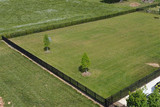The Importance of Following ICC Pool Code for Pool Fences: A Guide to Safety and Local Compliance
As a pool owner, your top priority should always be safety, especially when it comes to protecting your loved ones, guests, and the surrounding community. One critical aspect of pool safety is installing a compliant pool fence, which acts as a barrier to prevent accidental drownings, particularly for children. The International Code Council (ICC) has established a widely recognized International Swimming Pool and Spa Code (ISPSC), which outlines specific requirements for pool fences and barriers. However, it is essential to understand that while the ICC code is a reliable standard, you also need to consult local building codes to ensure full compliance.
Why Follow the ICC Pool Code?
- Enhanced Safety The ICC’s pool code focuses on establishing minimum standards for pool barriers that prevent unsupervised access to the water, especially by young children. According to the CDC, drowning is one of the leading causes of unintentional death for children under the age of 4. A secure pool fence that meets the ICC standards can help reduce these risks by making the pool area less accessible.
- Consistent Guidelines The ICC code offers a uniform standard that applies across multiple jurisdictions, making it easier for homeowners, builders, and inspectors to follow. By adhering to these guidelines, you can feel confident that your pool barrier meets a well-established and reliable safety benchmark.
- Legal and Insurance Requirements Many states and municipalities have adopted the ICC pool code as part of their building regulations. Not adhering to these standards can result in fines, and in some cases, invalidate your insurance coverage in the event of an accident. It’s not just about safety—it’s about being compliant with the law.
Key ICC Pool Fence Requirements
Some of the primary requirements outlined in the ICC pool code include:
- Fence Height: Pool fences must be at least 48 inches high with rails spaced more than 45 inches apart to prevent children from climbing over.
- Gaps and Openings: The fence must not have gaps or openings larger than 4 inches, and horizontal components must be spaced far enough apart to prevent climbing.
- Gate Specifications: Gates should be self-closing and self-latching, with the latch placed at least 54 inches from the ground to deter children from unlocking it.
- Distance from Pool: The pool fence must be installed at a safe distance from the edge of the pool to prevent anyone from falling directly into the water if they breach the barrier.
These standards provide a baseline for pool safety, but they may not account for regional variations or special circumstances, such as climate or unique terrain.
The Importance of Checking Local Codes
While the ICC’s standards are comprehensive, local authorities often modify or add specific requirements to better suit their communities. Your city, county, or state may have additional regulations that supersede or expand upon ICC guidelines. For example:
- Fence material: Some regions may mandate the use of specific materials (like mesh, aluminum, or wood) that are better suited to their climate.
- Height variations: While the ICC recommends a 48-inch height, your local code may require a taller fence due to high wind conditions or local concerns.
- Setback rules: Some jurisdictions require pool fences to be set back a certain distance from the property line or from the pool itself, beyond what the ICC specifies.
Checking with your local building department or homeowners' association (HOA) will help ensure that your pool fence meets all the necessary standards and helps you avoid penalties or the need for costly alterations.
Steps for Ensuring Full Compliance
- Consult Your Local Building Department Before beginning any construction or renovation, check with your local building authority for specific pool fence requirements. Many municipalities will have guidelines available on their website or at their office.
- Apply for Necessary Permits Most regions require a building permit for installing or modifying a pool fence. This ensures that the installation is inspected and compliant with local regulations.
- Request an Inspection Once your pool fence is installed, arrange for a building inspection to confirm that it meets both the ICC standards and any additional local requirements. This step is critical for ensuring that the fence is not only installed properly but is also up to code.
- Regular Maintenance After installation, you should regularly inspect your pool fence for any wear, damage, or shifting that could compromise its integrity. Many municipalities also have periodic re-inspections to ensure ongoing compliance.
Conclusion
Installing a pool fence that adheres to the ICC pool code and your local building requirements is an essential responsibility for any pool owner. Not only does it create a safer environment for children and pets, but it also shields you from potential legal and financial consequences. While the ICC code provides an excellent foundation for pool safety, it’s crucial to remember that local codes can vary. By working with your local authorities and a knowledgeable contractor, you can ensure that your pool fence is both safe and compliant, giving you peace of mind all season long.
Recent Posts
-
Experience, Reputation, Customer Service
Here’s why buying from OnlineFenceStore.com is a strong choice for fencing products: Key Advantages …Aug 13th 2025 -
How to Order Fence from OnlineFenceStore.com: A Step-by-Step Guide
How to Order Fence from OnlineFenceStore.com: A Step-by-Step Guide Ordering a fence online has never …Jul 30th 2025 -
Plumb vs. Level: Understanding the Difference in Fence Post Installation
When it comes to installing a fence, getting the job done right the first time is crucial. One of th …Jun 19th 2025







